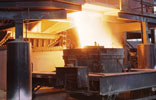

Zimalco, a division of the Zimco Group, is a leading South African producer of industrial and base minerals. Its products are used, amongst other applications, to dope bulk aluminium products to change the structure from brittle to soft. The product therefore needs to meet the highest industrial standards.
To ensure minimum losses when re-melting raw products, and for stirring requirements, Zimalco uses induction furnace heating based on resonant transformer action where the primary coil and capacitors are connected to a variable supply. The secondary coil is in fact the product to be heated and transformer configuration can be either in series or parallel. Induction furnace heaters have three main components: the furnace body, a capacitor bank to aid resonance and the power pack which supplies the furnace body with controlled power. These types of furnace have a wide power range; Zimalco’s induction furnaces range from 650 to 1000 kW.
Efficient operation requires tight control
According to PSY Systems’ Paul Young, induction heating is an extremely efficient means of converting electrical energy to heat, but there is one golden rule that must be followed: the furnace must run very close to unity power factor. “To achieve this, the output frequency of the power pack has to run in tight control at the resonating frequency of the furnace load, commonly known as the tank circuit. This circuit consists of the furnace crucible, the product in the crucible to be heated and the capacitors across the furnace primary coil.”
The existing controls required an exhausting number of operator settings to achieve the required control. In addition, production pressure exacerbated the fact that the operators were faced with the daunting task of overseeing multiple selector switches and control buttons. “We were approached to find a solution to the problem. In a nutshell, the team at PSY Systems needed to design a user friendly and efficient control system,” says Young. “The power circuit architecture of Zimalco’s furnace is current source inverter (CSI), whereas the incoming supply is rectified to DC via controlled bridge and feed to a large DC choke, which further supplies a single-phase inverter in a DC link configuration. The furnace coil and capacitors are parallel connected across the DC link as the load.”
The PSY Systems solution
Zimalco decided to keep all power circuits and only replace the controls. The new controls were based on the ABB AVANT AC800 series controller interfaced to two main control boards, one for the converter and the other for the inverter. “Due the maintenance records, which showed many failures from blow back into the control when any power device failed, it was decided to fibre link these control boards to the thyristers,” says Young.
The two main control boards were designed and manufactured by PSY Systems. These boards also included all relevant I/O signals for their main functions, that is, converter board signals including phase synchronising, fibre SCR gate signals, current feedback, current limit set point and power signal set point. The inverter board signals included, fibre SCR gate signals, frequency to voltage converter, coil voltage feedback and frequency set point. Finally, both boards were designed to interface to standard process controller signals based on digital inputs, digital outputs, analogue inputs and analogue outputs.
Commissioning took place from two main engineering tools: a notebook computer with ABB’s control builder software and an oscilloscope to monitor feedback and ensure tight control tuning. Process trails proved very successful with the furnace achieving record melt rates. Additional features were added such as the melt mode, which puts the furnace into high frequency and full power, as well as easy low-frequency selection for ultimate product mixing.
For more information contact Paul Young, PSY Systems, +27 (0)11 782 5449, [email protected], www.psysystems.com
| Email: | [email protected] |
| www: | www.actionindustries.co.za |
| Articles: | More information and articles about PSY International |

© Technews Publishing (Pty) Ltd | All Rights Reserved